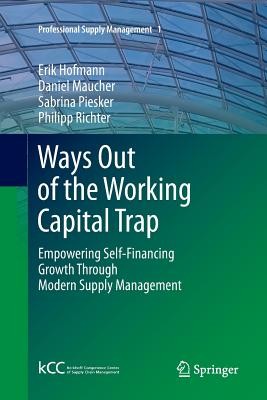
- We will send in 10–14 business days.
- Author: Erik Hofmann
- Publisher: Springer
- Year: 2013
- Pages: 94
- ISBN-10: 3642267653
- ISBN-13: 9783642267659
- Format: 15.6 x 23.4 x 0.6 cm, minkšti viršeliai
- Language: English
- SAVE -10% with code: EXTRA
Reviews
Description
Especially in times of an economic boom following a crisis, companies have to deal with the phenomenon of the working capital trap, which signifies a company's increasing need for financial liquidity in times of hindered access to debt capital, caused by the increasingly restrictive credit approval processes of financial institutions. As a consequence of cost savings, this situation is often reinforced by a low level of inventory.
This book takes up the problem and shows ways of escaping the trap by identifying and strengthening in-house financing potential. First, different operating ratios will be introduced. These refer to the amount of capital committed to the flow of goods and to the amount of in-house financing possible. Subsequently, methods for consolidating in-house financing that are affected by procurement processes will be presented from the company's and the supply chain's perspective.
From a company's perspective, the methods for consolidating the amount of in-house financing over the following topics: The Management of Payment Terms, Inventory Management and Product Group and Supplier Management
From the supply chain's perspective, the following methods for extending the possible amount of in-house financing will be discussed: Finance-Oriented Supply Chain Sourcing, Supply Chain-Oriented Supplier Financing, Collaborative Cash-to-Cash Management, Collaborative Cash Pooling and Netting, Supply Chain Financing Platforms.
The conceptual models will be clarified using a practical example from the automobile industry. Finally, the Procurement Value Added (PVA(c)) approach will be presented, a concept that measures the contribution of procurement to the company's success.
EXTRA 10 % discount with code: EXTRA
The promotion ends in 22d.15:16:24
The discount code is valid when purchasing from 10 €. Discounts do not stack.
- Author: Erik Hofmann
- Publisher: Springer
- Year: 2013
- Pages: 94
- ISBN-10: 3642267653
- ISBN-13: 9783642267659
- Format: 15.6 x 23.4 x 0.6 cm, minkšti viršeliai
- Language: English English
Especially in times of an economic boom following a crisis, companies have to deal with the phenomenon of the working capital trap, which signifies a company's increasing need for financial liquidity in times of hindered access to debt capital, caused by the increasingly restrictive credit approval processes of financial institutions. As a consequence of cost savings, this situation is often reinforced by a low level of inventory.
This book takes up the problem and shows ways of escaping the trap by identifying and strengthening in-house financing potential. First, different operating ratios will be introduced. These refer to the amount of capital committed to the flow of goods and to the amount of in-house financing possible. Subsequently, methods for consolidating in-house financing that are affected by procurement processes will be presented from the company's and the supply chain's perspective.
From a company's perspective, the methods for consolidating the amount of in-house financing over the following topics: The Management of Payment Terms, Inventory Management and Product Group and Supplier Management
From the supply chain's perspective, the following methods for extending the possible amount of in-house financing will be discussed: Finance-Oriented Supply Chain Sourcing, Supply Chain-Oriented Supplier Financing, Collaborative Cash-to-Cash Management, Collaborative Cash Pooling and Netting, Supply Chain Financing Platforms.
The conceptual models will be clarified using a practical example from the automobile industry. Finally, the Procurement Value Added (PVA(c)) approach will be presented, a concept that measures the contribution of procurement to the company's success.


Reviews